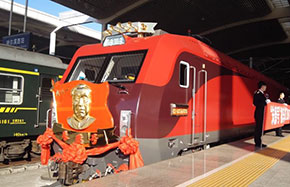Gaokao reform to boost vocational education talent
Having universities accept graduates from both vocational and regular high schools, which will be achieved by an upcoming reform, will bring positive changes to the country's talent pool, Chinese education expert says.
Lu Xin, vice-minister of education, said China will combine the current vocational training system with academic higher education and establish different models for each in the National College Entrance Examination, or gaokao.
Lu made her remarks at the 2014 China Development Forum in Beijing on Saturday.
She said that the gaokao system will have two tests - one for technically inclined students and one for academic ones.
The test for technically inclined students will be for prospective students of vocational training colleges who are aiming for careers such as engineering and mechanics. This exam will test mainly the students' technical skills and their textbook knowledge as a supplement.
The exams for academic students will test only the students' knowledge from schooling.
"This will enable students to make their career choices at the age of 16, when they are still in high school," Lu said. "Teenagers can realize their life goals based on their own choices of the type of study and career."
Tang Shengchang, a member of the National Education and Examination Steering Committee and former president of Shanghai High School, said that he is delighted to see the change, as it will bring positive and long-term improvements to the country's talent structure.
"The reform will send both vocational students and academic students into higher education of good quality," he said.
Lu said that Chinese technology workers work mainly in one of three fields: engineering, mechanics and highly educated labor forces. She said that vocational education has been focused on skill training, but in the future, the country will be in large demand of people with expertise. This means skilled workers need to better equip themselves with academic knowledge.
Lu said that about 600 local universities will be transformed into higher-education vocational colleges, which means that by the time the reform is in place, 70 to 80 percent of the country's higher education institutes will be geared toward vocational training.
At present, technically inclined students mainly refer to students from vocational high schools. Most of them will start looking for a job after graduating from high school. Only a small number of them seek further education in advanced vocational schools.
"For a long time, education in China has been focusing on academic learning because people regard academic learning as 'real' learning. People don't pay enough attention to skill training, especially in basic education," Tang said.
"This has resulted in the country's disadvantage to others in industrial techniques. For example, our architectural design is as good as other countries', but our manufacturing and construction techniques still have a lot of room for improvement."
Lu said that the reform of the gaokao system was approved during the executive conference of the State Council in late February. Details of the changes will be unveiled soon, she said.
However, reforming people's ideas about vocational education is already going on in parts of China. Lu said that in 2013, 1.4 million high school graduates sought higher vocational education.
"About 15 percent of high school graduates in Shanghai in 2013 entered higher vocational education," Tang said. "I am positive about their future job prospects."
About 17 million job hunters have entered the country's job market annually in recent years. College graduates are having an increasingly tougher time landing a job as more and more people with academic degrees are coming into the job market, but only people with high technical skills are in high demand.
zhangyue@chinadaily.com.cn


















